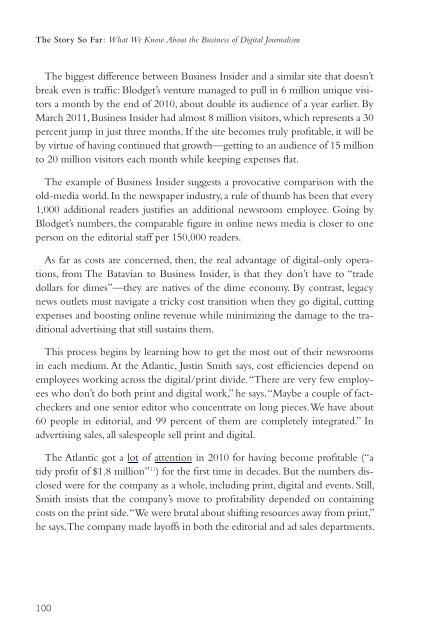What We Know About the Business of Digital Journalism
What We Know About the Business of Digital Journalism
What We Know About the Business of Digital Journalism
Create successful ePaper yourself
Turn your PDF publications into a flip-book with our unique Google optimized e-Paper software.
The Story So Far: <strong>What</strong> <strong>We</strong> <strong>Know</strong> <strong>About</strong> <strong>the</strong> <strong>Business</strong> <strong>of</strong> <strong>Digital</strong> <strong>Journalism</strong>The biggest difference between <strong>Business</strong> Insider and a similar site that doesn’tbreak even is traffic: Blodget’s venture managed to pull in 6 million unique visitorsa month by <strong>the</strong> end <strong>of</strong> 2010, about double its audience <strong>of</strong> a year earlier. ByMarch 2011, <strong>Business</strong> Insider had almost 8 million visitors, which represents a 30percent jump in just three months. If <strong>the</strong> site becomes truly pr<strong>of</strong>itable, it will beby virtue <strong>of</strong> having continued that growth—getting to an audience <strong>of</strong> 15 millionto 20 million visitors each month while keeping expenses flat.The example <strong>of</strong> <strong>Business</strong> Insider suggests a provocative comparison with <strong>the</strong>old-media world. In <strong>the</strong> newspaper industry, a rule <strong>of</strong> thumb has been that every1,000 additional readers justifies an additional newsroom employee. Going byBlodget’s numbers, <strong>the</strong> comparable figure in online news media is closer to oneperson on <strong>the</strong> editorial staff per 150,000 readers.As far as costs are concerned, <strong>the</strong>n, <strong>the</strong> real advantage <strong>of</strong> digital-only operations,from The Batavian to <strong>Business</strong> Insider, is that <strong>the</strong>y don’t have to “tradedollars for dimes”—<strong>the</strong>y are natives <strong>of</strong> <strong>the</strong> dime economy. By contrast, legacynews outlets must navigate a tricky cost transition when <strong>the</strong>y go digital, cuttingexpenses and boosting online revenue while minimizing <strong>the</strong> damage to <strong>the</strong> traditionaladvertising that still sustains <strong>the</strong>m.This process begins by learning how to get <strong>the</strong> most out <strong>of</strong> <strong>the</strong>ir newsroomsin each medium. At <strong>the</strong> Atlantic, Justin Smith says, cost efficiencies depend onemployees working across <strong>the</strong> digital/print divide. “There are very few employeeswho don’t do both print and digital work,” he says. “Maybe a couple <strong>of</strong> factcheckersand one senior editor who concentrate on long pieces. <strong>We</strong> have about60 people in editorial, and 99 percent <strong>of</strong> <strong>the</strong>m are completely integrated.” Inadvertising sales, all salespeople sell print and digital.The Atlantic got a lot <strong>of</strong> attention in 2010 for having become pr<strong>of</strong>itable (“atidy pr<strong>of</strong>it <strong>of</strong> $1.8 million” 11 ) for <strong>the</strong> first time in decades. But <strong>the</strong> numbers disclosedwere for <strong>the</strong> company as a whole, including print, digital and events. Still,Smith insists that <strong>the</strong> company’s move to pr<strong>of</strong>itability depended on containingcosts on <strong>the</strong> print side. “<strong>We</strong> were brutal about shifting resources away from print,”he says. The company made lay<strong>of</strong>fs in both <strong>the</strong> editorial and ad sales departments.100
















